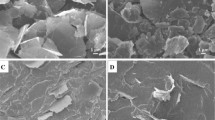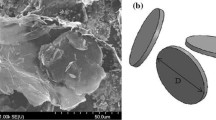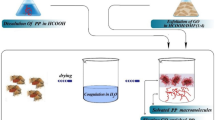Two methods are commonly used to disperse graphene nanoplatelets (GNPs) in a polymer matrix system (PMS) — microcompounding and ultrasonication. In this work, GNPs-PMS nanocomposite specimens of different weight ratios were first produced using microcompounding. Results of tensile tests showed that, on introduction of 0.5 wt.% GNPs into the PMS, its ultimate tensile strength (UTS) increased by 15% and the elastic modulus by 11%. Based on these results, 0.5 wt.% GNPs were also used in producing specimens by the ultrasonication technique, which showed a 69% drop in the UTS and a 227% increase in the elastic modulus. These findings demonstrate that the mechanical properties of GNPs-PMS nanocomposites are highly sensitive to their manufacturing method.






Similar content being viewed by others
References
R. Atif and F. Inam, “Reasons and remedies for the agglomeration of multilayered graphene and carbon nanotubes in polymers,” Beilstein Journal of Nanotechnology, 7, No. 1, 1174-1196 (2016).
R. Atif, I. Shyha, and F. Inam, “Mechanical, thermal, and electrical properties of graphene-epoxy nanocomposites—A review,” Polymers, 8, No. 8, 281-317 (2016).
S. Park and R. S. Ruoff, “Chemical methods for the production of graphenes,” Nature Nanotechnology, 4, No. 4, 217-224 (2009).
R. Atif and F. Inam, “Influence of macro-topography on damage tolerance and fracture toughness of 0.1 wt % multilayer graphene/clay-epoxy nanocomposites,” Polymers, 8, No. 7, 239-267 (2016).
E. Y. Choi, W. S. Choi, Y. B. Lee, and Y. Y. Noh, “Production of graphene by exfoliation of graphite in a volatile organic solvent,” Nanotechnology, 22, No. 36, 365601-365606 (2011).
X. Wang, J. Jin, and M. Song, “An investigation of the mechanism of graphene toughening epoxy,” Carbon, 65, 324-333 (2013).
Z. Li, R. Wang, R.J. Young, L. Deng, F. Yang, L. Hao, W. Jiao, and W. Liu, “Control of the functionality of graphene oxide for its application in epoxy nanocomposites,” Polymer, 54, No. 23, 6437-6446 (2013).
S. Liu, H. Yan, Z. Fang, and H. Wang, “Effect of graphene nanosheets on morphology, thermal stability and flame retardancy of epoxy resin,” Composites Science and Technology, 90, 40-47 (2014).
P-C. Ma, N. A. Siddiqui, G. Marom, and J-K. Kim, “Dispersion and functionalization of carbon nanotubes for polymer-based nanocomposites: A review,” Compos. Part A Appl. Sci. Manuf., 41, 1345–1367 (2010).
S. Bal and S. S Samal, “Carbon nanotube reinforced polymer composites—A state of the art,” Bulletin of Materials Science, 30, No. 4, 379-386 (2007).
S. Parveen, S. Rana, and R. Fangueiro, “A review on nanomaterial dispersion, microstructure, and mechanical properties of carbon nanotube and nanofiber reinforced cementitious composites,” Journal of Nanomaterials, 2013, 1-19 (2013).
C-X. Liu and J-W. Choi, “Improved dispersion of carbon nanotubes in polymers at high concentrations,” Nanomaterials, 2, 329–347 (2012).
S. K. and S. Sinha, “Epoxy-based carbon nanotubes reinforced composites,” in Advances in Nanocomposites - Synthesis, Characterization and Industrial Applications, InTech, INTECH Open Access Publisher (2012).
J. J. Karippal, H. N. N. Murthy, K. S. Rai, M. Krishna, and M. Sreejith, “The processing and characterization of MWCNT/epoxy and CB/epoxy nanocomposites using twin screw extrusion,” Polymer-Plastics Technology and Engineering, 49, No. 12, 1207-1213 (2010).
S. T. Buschhorn, M. H. G. Wichmann, J. Sumfleth, K. Schulte, S. Pegel, and G. R. Kasaliwal, “Charakterisierung der Dispersionsgüte von Carbon Nanotubes in Polymer-Nanokompositen,” Chemie Ingenieur Technik, 83, No. 6, 767-781 (2011).
S. I. Abdullah and M. N. M. Ansari, “Mechanical properties of graphene oxide (GO)/epoxy composites,” HBRC Journal, 11, No. 2, 151–156 (2015).
D. Galpaya, M. Wang, C. Yan, M. Liu, N. Motta, and E. R. Waclawik, “Fabrication and characterisation of graphene oxide-epoxy nanocomposite,” Fourth International Conference on Smart Materials and Nanotechnology in Engineering, September 2013.
E. Dervishi, F. Hategekimana, L. Boyer, F. Watanabe, T. Mustafa, A. Biswas, A. R. Biris, and A. S. Biris, “The effect of carbon nanotubes and graphene on the mechanical properties of multi-component polymeric composites,” Chemical Physics Letters, 590, 126–130 (2013).
B. Debelak and K. Lafdi, “Use of exfoliated graphite filler to enhance polymer physical properties,” Carbon, 45, No. 9, 1727–1734 (2007).
C. E. Corcione, F. Freuli, and A. Maffezzoli, “The aspect ratio of epoxy matrix nanocomposites reinforced with graphene stacks,” Polymer Engineering & Science, 53, No. 3, 531–539 (2012).
L. Ramos-Galicia, L. N. Mendez, A. L. Martínez-Hernández, A. Espindola-Gonzalez, I. R. Galindo-Esquivel, R. Fuentes-Ramirez, and C. Velasco-Santos, “Improved performance of an epoxy matrix as a result of combining graphene oxide and reduced graphene,” Int. J. Polym. Sci., 2013, 1-7 (2013).
R. Di Sante, “Fibre optic sensors for structural health monitoring of aircraft composite structures: Recent advances and applications,” Sensors (Switzerland), 15, No. 8, 18666–18713 (2015).
W. Liu, K. L. Koh, J. Lu, L. Yang, S. Phua, J. Kong, Z. Chen, and X. Lu, “Simultaneous catalyzing and reinforcing effects of imidazole-functionalized graphene in anhydride-cured epoxies,” J. Mater. Chem., 22, No. 35, 18395-18402 (2012).
H. Yang, C. Shan, F. Li, Q. Zhang, D. Han, and L. Niu, “Convenient preparation of tunably loaded chemically converted graphene oxide/epoxy resin nanocomposites from graphene oxide sheets through two-phase extraction,” J. Mater. Chem., 19, No. 46, 8856-8860 (2009).
T. Villmow, B. Kretzschmar, and P. Pötschke, “Influence of screw configuration, residence time, and specific mechanical energy in twin-screw extrusion of polycaprolactone/multi-walled carbon nanotube composites,” Compos. Sci. Technol., 70, No. 14, 2045–2055 (2010).
L. Cao, X. Liu, H. Na, Y. Wu, W. Zheng, and J. Zhu, “How a bio-based epoxy monomer enhanced the properties of diglycidyl ether of bisphenol A (DGEBA)/graphene composites,” Journal of Materials Chemistry A, 1, No. 16, 5081-5088 (2013).
L. C. Tang, Y. J. Wan, D. Yan, Y. B. Pei, L. Zhao, Y. B. Li, et al., “Improved dispersion and interface in the graphene/epoxy composites via a facile surfactant-assisted process,” Composites Science and Technology, 82, 60-68 (2013).
Z. A. Ghaleb, M. Mariatti, and Z. M. Ariff, “Properties of graphene nanopowder and multi-walled carbon nanotube-filled epoxy thin-film nanocomposites for electronic applications: The effect of sonication time and filler loading,” Composites Part A: Applied Science and Manufacturing, 58, 77–83 (2014).
J. A. King, D. R. Klimek, I. Miskioglu, and G. M. Odegard, “Mechanical properties of graphene nanoplatelet/epoxy composites,” Journal of Composite Materials, 49, No. 6, 659–668 (2015).
X. Wang, L. Song, W. Pornwannchai, Y. Hu, and B. Kandola, “The effect of graphene presence in flame retarded epoxy resin matrix on the mechanical and flammability properties of glass fiber-reinforced composites,” Composites Part A: Applied Science and Manufacturing, 53, 88–96 (2013).
W. P. Serena Saw and M. Mariatti, “Properties of synthetic diamond and graphene nanoplatelet-filled epoxy thin film composites for electronic applications,” Journal of Materials Science: Materials in Electronics, 23, No. 4, 817–824 (2012).
I. Zaman, H. C. Kuan, Q. Meng, A. Michelmore, N. Kawashima, T. Pitt, L. Zhang, S. Gouda, L. Luong, and J. Ma, “A facile approach to chemically modified graphene and its polymer nanocomposites,” Advanced Functional Materials, 22, No. 13, 2735–2743 (2012).
D. Galpaya, M. Wang, G. George, N. Motta, E. Waclawik, and C. Yan, “Preparation of graphene oxide/epoxy nanocomposites with significantly improved mechanical properties,” Journal of Applied Physics, 116, No. 5, 53518-53528 (2014).
W. Li, A. Dichiara, and J. Bai, “Carbon nanotube–graphene nanoplatelet hybrids as high-performance multifunctional reinforcements in epoxy composites,” Composites Science and Technology, 74, 221–227 (2013).
T. K. Bindu Sharmila, A. B. Nair, T. A. Beena, P. M. S. Beegum, and E. T. Thachil, “Microwave exfoliated reduced graphene oxide epoxy nanocomposites for high performance applications,” Polymer, 55, 3614-3627 (2014).
C. Valles, A. M. Abdelkader, R. J. Young, and I. A. Kinloch, “The effect of flake diameter on the reinforcement of few-layer graphene–PMMA composites,” Composites Science and Technology, 111, 17-22 (2015).
B. Mayoral, E. Harkin-Jones, P. Khanam, A. Noorunnisa, M. A. Ouederni, A. R. Hamilton, and D. Sun, “Melt processing and characterisation of polyamide 6/graphene nanoplatelet composites, ” RSC Advances, 5, 52395-52409 (2015).
J. Zhong, A. I. Isayev, and X. Zhang, “Ultrasonic twin screw compounding of polypropylene with carbon nanotubes, graphene nanoplates and carbon black,” European Polymer Journal, 80, 16-39 (2016).
C. Gonçalves, A. Pinto, A. V. Machado, J. Moreira, I. C. Gonçalves, and F. Magalhães, “Biocompatible reinforcement of poly(Lactic acid) with graphene nanoplatelets,” Polym. Compos., 39, 308-320 (2018).
G. Zhenghong, R. Shiya, and F. Zhengping, “Promoting dispersion of graphene nanoplatelets in polyethylene and chlorinated polyethylene by Friedel–Crafts reaction,” Composites Science and Technology, 86, 157-163 (2013).
M. A. Rafiee, J. Rafiee, Z. Wang, H. Song, Z-Z. Yu, and N. Koratkar, “Enhanced mechanical properties of nanocomposites at low graphene content,” ACS Nano., 3, 3884-90 (2009).
L. S. Walker, V. R. Marotto, M. A. Rafiee, N. Koratkar, and E. L. Corral, “Toughening in graphene ceramic composites,” Acs Nano, 5, 3182-3190 (2011).
M. Martin-Gallego, M. M. Bernal, M. Hernandez, R. Verdejo, and M. A. Lopez-Manchado, “Comparison of filler percolation and mechanical properties in graphene and carbon nanotubes filled epoxy nanocomposites,” Eur Polym J, 49, 1347-53 (2013).
L. Ma, G. Wang, and J. Dai, “Preparation and properties of graphene oxide/polyimide composites by in situ polymerization and thermal imidization process,” The Journal of High-Performance Polymers, 29, 187-196 (2017).
A. Algarni, “Enhancing the Mechanical Properties of Aerospace Fiber Reinforced Polymer Composite Materials using Nanoparticles,” PhD Thesis, King Abdulaziz University, KSA (2018).
ASTM D638 - 14, Standard Test Method for Tensile Properties of Plastics, ASTM International, West Conshohocken, PA, 2002, www.astm.org (refernce date 14.04.2018).
Y. Jiang, H. Song, and R. Xu, “Research on the dispersion of carbon nanotubes by ultrasonic oscillation, surfactant and centrifugation respectively and fiscal policies for its industrial development,” Ultrason Sonochem, 48, 30–38 (2018).
K. Almuhammadi, M. Alfano, Y. Yang, and G. Lubineau, “Analysis of interlaminar fracture toughness and damage mechanisms in composite laminates reinforced with sprayed multi-walled carbon nanotubes,” Mater. Des., 53, 921–927 (2014).
I. Alig, P. Pötschke, D. Lellinger, T. Skipa, S. Pegel, G. R. Kasaliwal, and T. Villmow, “Establishment, morphology and properties of carbon nanotube networks in polymer melts,” Polymer (Guildf), 53, 4–28 (2012).
Acknowledgment
This Project was funded by the Deanship of Scientific Research (DSR), King Abdulaziz University, Jeddah, under grant No. (202/135/1431), whose financial support is gratefully acknowledged by the authors.
Author information
Authors and Affiliations
Corresponding author
Additional information
Russian translation published in Mekhanika Kompozitnykh Materialov, Vol. 55, No. 5, pp. 000-000, September-October, 2019.
Rights and permissions
About this article
Cite this article
Bourchak, M., Nahas, M.N., Kada, B. et al. Tensile Properties of Graphene-Based Nanocomposites: a Comparative Study of Ultrasonication and Microcompounding Processing Methods. Mech Compos Mater 55, 617–626 (2019). https://doi.org/10.1007/s11029-019-09838-5
Received:
Revised:
Published:
Issue Date:
DOI: https://doi.org/10.1007/s11029-019-09838-5




